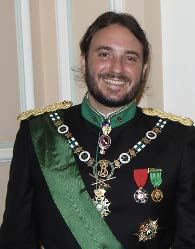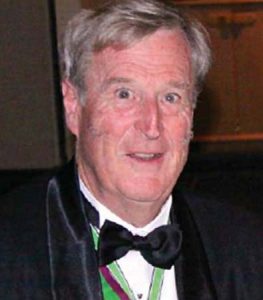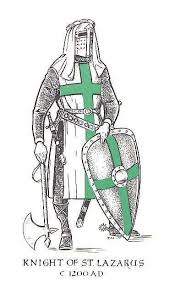
The Australian Priory of the Order of St Lazarus
Under the governance of the 50th Grand Master,
His Excellency Don Francisco de Borbón, Graf von Hardenberg GCLJ (J) GClLJ

The Grand Prior of the Order in Australia is
The Hon. Chevalier Gavin L. Fielding AM GCLJ GCMLJ

The Chancellor of the Order in Australia is
Chevalier David G. Slater AM KCLJ OMLJ
The National Council is responsible for the administration of the Order in Australia
There are Seven Commanderies in the Australian Grand Priory:
ACT, NSW, Qld, SA, Tas, Vic, WA

NATIONAL DIRECTORY
National Council
Grand Prior: The Hon. Chevalier Gavin L. Fielding AM GCLJ GCMLJ
Chancellor: Chevalier David G. Slater AM KCLJ OMLJ
Referendary: Mr Anthony J. Gissing CLJ
National Chaplain: The Very Reverend Peter G. Williams AM VG SChLJ
National Treasurer: Ms Rosemary Everett CLJ
Marshal: Chevalier Air Commodore Dr Peter McDermott AM CSC KLJ RAAF (Retd)
National Almoner: Mrs Margaret Heathcote CLJ
National Hospitaller: Chevalier Rosalind Lawrence DLJ OMLJ
Immediate Past Grand Prior: Chevalier Willoughby Bailey AO GCLJ GCMLJ GCrLJ (dec’d)
Presidents of Commanderies
ACT: Chev Dr John Donovan ED KLJ CMLJ
NSW: Chevalier Martin Dowling KLJ
QLD: Captain David Ellis OAM MNSC CLJ
SA: Mr Joseph Thorp CLJ
TAS: Chevalier Don McLeod KLJ OMLJ
VIC: Dame Robin Richards DLJ
WA: The Very Reverend Dr John Shepherd AM ChLJ OMLJ
Special Appointments
Secretary-General Dame Bernadette Azizi DLJ
Deputy Chancellor Chevalier Ross Sweet AM KLJ OMLJ
National Herald: Chevalier Major John G. Hitchen ED KLJ OMLJ (Retd)
Deputy National Chaplain:
The Right Reverend Dr Chris Jones ChLJ CMLJ
Custodian of Insignia: Mr Rob Clyne OAM CLJ
National Archivist: Chevalier John Molnar OAM KLJ OMLJ
_________________________________________________________________
About the Australian Grand Priory
The Military and Hospitaller Order of Saint Lazarus of Jerusalem is an international Christian chivalric Order. It is non-political, ecumenical and non-denominational, its membership is by invitation and is open to men and women who are practising members of the Christian faith in good standing within their particular denomination. Its international membership consists of Roman Catholic, Anglican, Protestant, Orthodox and other Christian denominations.
The Military and Hospitaller Order of Saint Lazarus of Jerusalem is an international self-governing and independent body, having its own Constitution and a presence in 37 countries.
Its members are committed to seeking to live their lives with charity in a manner that embodies the Christian spirit. The Order is dedicated to the care and assistance of the poor and the defence of the Christian faith and the principles of Christian chivalry.
The Order has been in continual existence since the year 1098 and was established in Australia in 1979. The Grand Priory of Australia comprises seven Commanderies centred on the various capital cities.
Membership is confined to a Commandery. Commandery activities include meetings, special religious services and fundraising events. The Order is both a military and a hospitaller order. Accordingly, there are ranks of membership. Advancement through the Order is largely dependent on the member’s commitment to giving, and their voluntary work within and outside the Order. Christian worship and ceremony underpins the Order’s charitable works. In addition to promotion through the ranks of the Order, awards are made for services rendered to supported charities or to the Order itself.
An International Christian Chivalric Order
We are part of an international organisation. There is a Grand Magistry which oversights Jurisdictions in countries across the world. The Grand Magistry website can be found at: st-lazarus.net.
We have a Grand Master (currently the 50th in a long line of Grand Masters): His Excellency Don Francisco de Borbón, Graf von Hardenburg – Spain (picture at right).
The traditional headquarters in the past have been at Boigny, in France, and the Castello Lanzun, in Malta, which has been fully restored and also contains the Order’s archives. The seat of the Order is now in Madrid (the residence of the Grand Master) in the San Domingo el Real monastery, and the Grand nobiliary proofs, and Grace for other members
Members rank in the following grades: Member, Officer, Commander, Knight or Dame, Knight or Dame Commander, Knight or Dame Grand Cross. As a mark of the Grand Master’s special esteem, the Order may also award a Collar to a head of State and very occasionally to its high dignitaries. The Order also confers decorations of merit to its members and to individuals not necessarily members of the Order who have contributed, by their service, to its humanitarian work.
The Order is wholly Christian, ecumenical and non-denominational and has Christian unity as an objective. The members are committed to seek to live their lives with strength, simplicity and charity in a manner that embodies the Christian spirit that has enlivened the Order for nearly a thousand years. The Order is, in part, a military Order and so each office-bearer under- takes the duties allotted and becomes the officer primarily responsible for their fulfilment, earning the support and active assistance of fellow members. The Order is, in part, a hospitaller Order and so its objective will always be that members serve to alleviate the plight of the sick and poor, whether they suffer a deficiency in spiritual or physical health, or a poverty of means necessary to live with dignity.
Every person proposed for admission into the Order must be a practising member of the Christian faith and shall be of sound mind and of such means and position as will enable him or her to live honourably and to observe the laws and decrees of the Order. Each Postulant must prove that he or she is a person of irreproachable conduct, honour and integrity.
A number of obligations are demanded of members when admitted to the Order. All members have to observe the Constitution of the Order and to obey their senior officers. There are some financial obligations. Each member is required to pay annual fees and to give funds (according to their own discretion) and provide services (according to ability) to the hospitaller work for the sick, the homeless and disadvantaged members of the community who are in need.
Also it is expected that every member will endeavour, where possible, to support the Order by attendance at as many of its events as possible including Commandery meetings, Commandery functions, the Commandery annual Saint Lazarus service, annual National Chapter meetings and Investitures. There are also international meetings which members can attend. Members are encouraged to pray regularly for the well-being and extension of the Order.
Governance of The Order
The Grand Master is the supreme head of the Order and to him is delegated all power and authority of the Chapter General. The Chapter General, is the supreme governing body and repository of all power in the Order, when convened. When the Chapter General it not convened, this power is delegated to, and vested in the Grand Master. The Grand Magistral Council is the principal policy making body of the Order. The Grand Executive Committee is the principal governing body of the Order, with responsibility to oversee and co-ordinate the execution of the policies adopted by the Grand Magistral Council. The Grand Master appoints the Principal Grand Officers of the Order – the most senior being the Grand Commander of the Order. The Heads of National Jurisdictions are appointed by the Grand Master on the recommendation of the relevant national body.
Chancery and administrative offices are in Washington DC. While the Order’s original and traditional humanitarian activities are in the field of leprosy, the Order is dedicated to guard, assist, succour and help the poor, the sick and dying, to promote and maintain the principles of Christian chivalry and to follow the teachings of Christ and His Holy Church in all its works.
The Order looks to His Beatitude, Youssef Absi, Greek Melkite Patriarch of Antioch and all the East, of Alexandria and Jerusalem, for spiritual support as the constitutional Spiritual Protector.
There are two categories of membership in the Order: Justice, for individuals able to submit
Its world membership numbers approximately 7000 members in Grand Priories, Grand Bailiwicks, Priories, Commanderies and Delegations on the five continents.
Members agree that the principal features of the Order’s activities are the enjoyable atmosphere of social engagement with like-minded people in a formal setting, with the deep sense of gratification that can only come from successful fundraising for the chosen charities.
The Australian Grand Priory has in recent years raised hundreds of thousands of dollars per annum from fundraising activities.
National Chapter
Once a year a National Chapter – effectively a general meeting of the Grand Priory of Australia – is held in a capital city over four days and to which all members are invited. The National Chapter includes the Investiture of new members and the advancement in rank or award of others
Members rank in the following grades: Member, Officer, Commander, Knight or Dame, Knight or Dame Commander, Knight or Dame Grand Cross. As a mark of the Grand Master’s special esteem, the Order may also award a Collar to a head of State and very occasionally to its high dignitaries. The Order also confers decorations of merit to its members and to individuals not necessarily members of the Order who have contributed, by their service, to its humanitarian work.According to our Christian beliefs, charity is held to be the ultimate expression of the human spirit, bringing us closer to the true essence of God. The activities of the Order attempt to bring its members towards this state of grace through application of charitable giving and hands-on charitable activities.
A Brief History of the Order
► In 1098, Gerard (Master of a hospital within the walls of Jerusalem) took over the leper hospital outside the north wall (established centuries earlier by St Basil) and this hospital was dedicated to St Lazarus – thus Blessed Gerard is cited as the first Master of the Order of Saint Lazarus.
► In 1099, Jerusalem was captured by the crusaders in bloody fighting and then what followed was almost two hundred years of warfare as the Christian states fought for survival against the ousted but aggressive Moslem forces.
► Those dedicated to the care and welfare of the Saint Lazarus lepers were purely hospitallers and mostly monks, but with the steady influx into Jerusalem of crusading knights who were contracting the dreaded disease, the character of the Order gradually evolved to become military.
► In 1150, after the second crusade of King Louis VII of France, the Order of Saint Lazarus began to expand in Europe and particularly in France.
► In about 1157, a green cross was adopted as the Order’s badge, green then being the traditional colour for hospital services.
► In 1308, following tumultuous times in the East, King Phillip IV of France placed the Order under his protection.
► The Order’s military role declined by the 15th Century and the 16th Century found the Order at a low ebb – suppressed at the time by the Reformation.
► Then in 1772, as a result of its diminished religious character, the Order of Saint Lazarus was secularised by Pope Clement XIV and although no longer a monastic Order, its religious character was maintained through its chaplains.
► By decree on 31 December 1778, the Order’s motto was changed from Dieu et Mon Roi to Atavis et Armis, freely translated as ‘With Compassion and Arms’.
► When France took the path of revolution, the Order was illegally suppressed by the French Republic and then followed years of disruption for the Order but which eventually resulted in the Grand Master becoming King Louis XVIII of France in 1814.
► About 1837, following further State suppression the Order looked east for protection to the lands of the Order’s origins and the Melkite-Greek Catholic Church
► In 2008, the separate Paris and Malta obediences of the Order (following a split in 1969) were success- fully united under His Excellency Don Carlos Gereda de Borbón, Marquis de Almazàn as the 49th Grand Master installed in the presence of the Spiritual Protector of the Order, His Beatitude Gregory III, the Greek Melkite Catholic Patriarch of Antioch and all the East, of Alexandria and Jerusalem.
A Brief History of the Grand Priory of Australia
The Order under the Magistry of the Duke of Brissac commenced in Australia in November 1979 with the appointment of Alderman Ray Bagdonas as a Commander.
The following year by a Magistral Decree of 15th March 1980 Australia was created a National Delegation with Cmd. Bagdonas appointed as Delegate. His first task was to recruit suitable members which he did in New South Wales throughout 1980.
On 25th May 1981 the Australian Delegation held its first meeting at the Union Club where it was agreed to meet an appeal for assistance from Sister Pat Swan a psychiatric nurse for a day care/activity centre for the mentally ill in the Campbelltown area of Sydney. As a result the Order leased premises in Campbelltown and agreed to provide ongoing funding with the staffing provided by the local Area Health Service. The centre, called St. Lazarus House, was opened by the Mayor of Campbelltown on 1st August 1981. The members in New South Wales continued to meet monthly and further recruitment was carried out. The success of the Campbelltown St. Lazarus House brought a Health Commission request for a similar facility at Bankstown and the Order leased premises and funded this day care centre which was opened on 8th May 1982. Commander Bagdonas represented the Order on the management committees of both houses. The Sydney press and television widely reported on the work of the Order and both St. Lazarus Houses.
The Delegate, realizing that the Delegation to be a truly national body needed membership from other States recruited members to form a sub-delegation in Victoria. The Victorian sub-delegation or branch held its first meeting on 5th December 1982 in Sydney when members attended an Investiture at St. John’s Anglican Church, Gordon, which was the Order’s chapel. Sir Donald Trescowthick KBE CLJ was elected the first president of the Victorian branch. The next branch to be established was Queensland in November 1983 with Cmd. Denis Galligan, QC., the Solicitor General, as its first president. In November 1983 Queensland and Victorian members attended a reunion and investiture at St. Mary’s Catholic Cathedral in Sydney. A branch was established in the Australian Capital Territory on 11th May 1984 with the Hon. Justice John Kelly as President. With all state branches meeting regularly recruitment took place for a branch in South Australia which was formed at an inaugural meeting at the Adelaide Club on 9th October 1984 with Cmd. Lewis Barrett OBE, elected branch President. Victoria and Queensland had made no further progress with recruitment, so the Delegate Cmd. Bagdonas resumed a membership drive which placed both branches on a sounder footing. The Order’s new-found strength and national identity was reflected by the attendance of members from all State branches at a National Reunion and Investiture held at Canberra on 15th December 1984.
Recognition for the Order’s strong growth in Australia was given when on the 10th April 1985 by the Magistral Decree No. 85, a Grand Bailiwick covering Australia and the South Pacific region was created. The Delegate Ray Bagdonas, was made the Order’s first knight. The next national reunion was held in Adelaide in February 1987 followed by Melbourne in February 1988 where the newly formed Tasmanian Commandery had its inaugural meeting electing the Hon Ken Lowrie as its first President or Commander. All commanderies meet regularly, usually every two months or so, hold annual general meetings to elect their executive officers while the Grand Bailiwick holds a national chapter and investiture annually. Each Commandery carries out its own humanitarian work, as does the Bailiwick on projects initiated by the National Council and the Grand Bailiff. Thanks to the efforts of its members the Order has made great progress over a short period of time making a positive contribution in aid of the sick or suffering and to the ecumenical Christian ideal.
